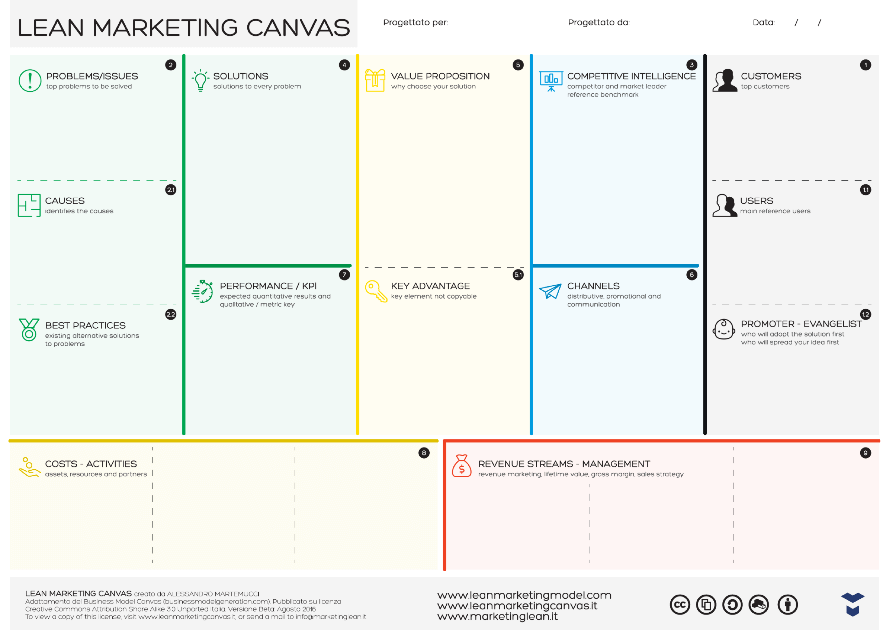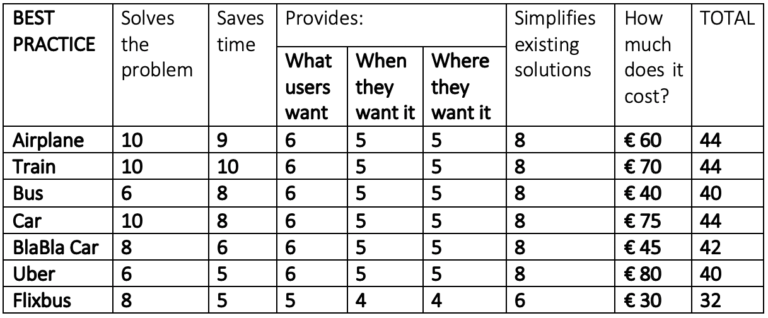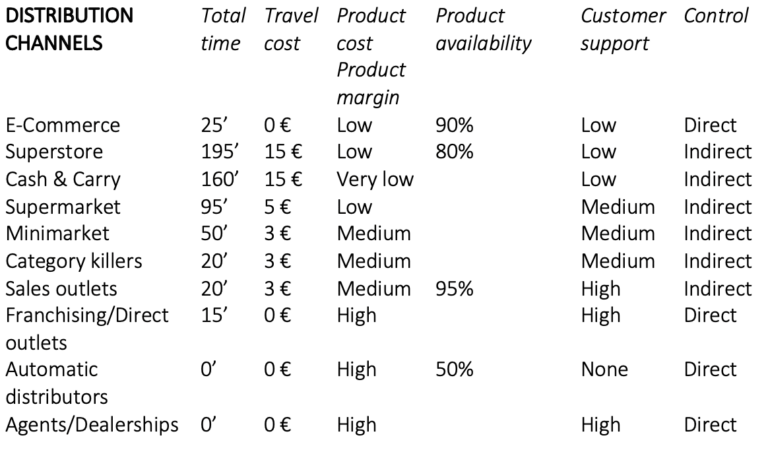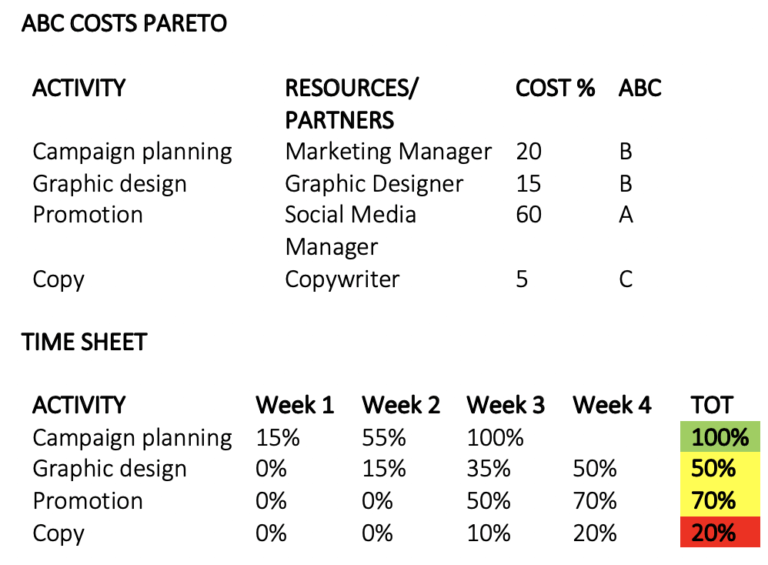FEATURE – Tools and framework help us to bring lean principles to life and act on our strategies. The author introduces the Lean Marketing Canvas.
Words: Alessandro Martemucci, Lean Coach, Istituto Lean Management – Italy
In a previous article, I have discussed a strategic approach to marketing based on Lean Thinking – the Lean Marketing Model – but what about the operational tools that can turn our strategy into action?
Building on the A3 model, the lean practitioner’s reference for problem solving, I have come up with the Lean Marketing Canvas. This tool derives from two previous models – Osterwalder and Pigneur’s Business Model Canvas and Ash Maurya’s Lean Canvas – to which I have added a number of elements.
The Canvas can be used to design and test a company’s value proposition by means of an iterative analysis of customer needs that has its foundations in PDCA. It can support organizations as they try to build (or assess) sales and marketing strategies that – in true lean style – start from customer problems and work backwards.
The Canvas consists of nine sections, starting from either Customers (section 1) or Problem (section 2). The only constraint is the availability of the resources and skills we need to prototype a product and turn our plan into a reality. There is no point in aiming to disrupt the market if our plan is unattainable or requires resources we don’t have. It’s better to have a measurable objective of an immediate or short-term lean improvement within a long-term strategy. Our actions need to be tested right away to validate their effectiveness and proceed or pivot based on what we find out – it’s the so-called “trystorming”.
CUSTOMERS/USERS/INFLUENCERS
The first section in the Canvas identified three key figures in marketing, who greatly influence the purchasing process and must be taken into account when designing a strategy – customers (who pays for/chooses the solution), users (who uses/benefits from the solution) and influencers (who first publicizes/disseminates the solution). Don’t forget that different types of customers or users require different canvases.
Customer and user may coincide, but most of the time they are different people. Let’s look at toddler biscuits as an example. Parents are the customer (they buy the product), but toddlers are the real users (they eat the biscuits). The same happens in the B2B market: in retail, for instance, the distributor pays, the buyer chooses the product, and the end costumer actually re-purchases and uses it.
When it comes to marketing, this distinction is crucial because it will inform both our strategy and communication plan. In B2B, for example, distinguishing between customer and user helps you to understand who makes decisions on how much to spend on what – which in turn will inform your selling strategy.
Influencers represent a great opportunity because of their ability to capture the imagination and the attention of users and encourage them to purchase a product or a service. (And social media influencers are just a small part of this category.) In the biscuits example, our influencers could be relatives, parents, a pediatrician, or a supermarket salesperson. Influencers are often existing customers who are satisfied and recommend our product with friends, family, colleagues, etc. That’s why they are often called “evangelists”. They are loyal to a brand, know the product inside out – at times better than those selling it – and their endorsement is priceless.
SOLVING CUSTOMER PROBLEMS, MEETING THEIR NEEDS, DELIGHTING THEM
The second section of the Lean Marketing Canvas aims to identify problems, customer needs, and to delight customers. For us lean thinkers, problems are opportunities to improve and stay competitive.
Today’s sales and marketing activities need to focus on real customer problems. That’s where the development of a product or service should really start. Finding problems also gives us the chance to improve our service and the all-important customer experience.
But what does it really mean to find solutions to real customer problems? It’s easy to confuse problems with their symptoms or alleged causes, which leads to respectively not tackling the root causes of the problem or focusing on the wrong causes and therefore coming up with ineffective countermeasures. Lean Thinking places great emphasis on the need for everyone in a business to participate in problem solving, from front-line staff to leaders, with a continuous improvement attitude.
Only by knowing the root cause can we solve the problem once and for all. Lean tools at our disposal that can help us identify the root causes of problems include the 5 Whys method and the Ishikawa diagram.
COMPETITIVE INTELLIGENCE
Once we have identified the problem and its causes, the Canvas encourages us to look around for alternative solutions and other best practices of our competitors. How are they solving the same customer problems? What solutions do they come up with?
In my mind, this is the most innovative part of the Canvas. Market and competitor analysis is missing from all the other models I have come across, even though knowing where we stand against our competition is vital. Such investigation allows us to learn if there already are similar solutions in the market, to draw inspiration from other markets, to identify market leaders and benchmark against competitors.
We want as wide an overview as we can get here, so we shouldn’t only consider market players but also other potential competitors. It’s also useful to check for any alternative products or solutions that are used to tackle a customer problem even though that wasn’t their intended use originally.
Here’s an example. There are many ways to travel between Milan and Rome – car, train, airplane, but, BlaBlaCar, taxi, and so on. If I focus on the business segment of the market, however, I quickly realize that the need to reach the destination quickly narrows down our options to two: high-speed train or airplane. Evaluating competitors or market players in a more analytical way tells us that, really, Alitalia’s main competitor is not low-cost airline Ryanair, but the high-speed train.
It’s very important to know how to evaluate, compare and measure existing alternatives from a cost/benefit point of view. What is the cost of providing this solution to the customer in the way they want it?
To see where we stand in the market, we can rely on well-known tools like the SWOT matrix to identify our company’s strength and weaknesses and the opportunities and threats we might encounter in the market.
This analysis couldn’t be more important because it allows us to understand if there are gaps in the current offering available in the market that we can fill with our product. It also helps us to better plan for the development of a new product based on the choices competitors made or optimize our time to market thanks to the information we can gather on what others in the same sector are doing.
FINDING SOLUTIONS
The fourth section in the Canvas defines our solutions to customer problems that we will then transform into products or services. This is why it’s important to understand at this stage how our value proposition tackles each of the customer problems we have identified. Comparing two or three key proposed solutions results in a matrix that helps us to know right away what product or what strategy to focus on.
This model summarizes the principles of lean consumption, giving us a way to evaluate the effectiveness of our solution against each of these principles. The solution that obtains the highest score is the first one to develop. If it’d not received well by customers, we can move on to the second one, then the third one, and so on.
Besides the solutions matrix, we have another weapon in our arsenal to better understand the characteristics of the product or improve its performance and therefore build a winning brand proposition in the following section. This tool is very useful to understand how our product fares in the market and to identify the winning solution. It’s called Measuring Design Value. With canvases and cards, its Communication Toolkit helps us to gauge how a product, service, solution, process or even marketing strategy are perceived at three key levels – functional utility (does it work and solve a customer problem?), social utility (which measures its appeal and how it’s perceived) and emotional utility (how does it make people feel?).
THE VALUE PROPOSITION
This section is entirely devoted to the description of our value proposition and brand position. This is where we list the characteristics of our solution, essentially trying to answer the question of why customers should choose it over others.
First, we need to define the “elements of value” that can determine the success or the failure of the strategy or set our solution apart from our competition’s. This Harward Business Review article identifies a pyramid with 30 elements of value organized in four categories corresponding to four types of customer needs (functional elements, emotional elements, life-changing elements, and social impact).
This important section contains everything that will be offered to the customer, besides just the product.
To help a company identify the critical success factors, it is a good idea to provide customers with a customer satisfaction survey to see what elements of the value proposition they find most important. The one that customers highlight as the most critical is, of course, the one you’ll invest in. A delighted customer is the best ambassador for your products.
In the KEY ADVANTAGE sub-section, we need to determine what the unique selling point (or key advantage) of our solution is, that factor that makes us different in the eye of the customer. This can be a patent, a brand, a partnership, our company’s reputation, and so on. For Apple, for instance, it’s design, for Coca-Cola it’s the power of the brand, for BMW it’s performance.
A value proposition is made up of products and services that solve problems and generate advantages for customers. It’s of course very hard to solve all of their problems with a single value proposition, which is why it’s advisable to concentrate on the most pressing issue they face – where you can make the difference and gain competitive advantage.
At this point, we will need to build our brand positioning, one of the most difficult things we need to do (you might want to read Al Ries and Kack Trout’s Positioning: the Battle for Your Mind).
DISTRIBUTION, PROMOTIONAL AND COMMUNICATION CHANNELS
How will our value proposition reach the customer? Through which channels? How does the customer want to be reached? How do the channels interact? Which ones are the most suitable? How do they integrate with customer habits and the user experience? These are the questions we need to answer in the sixth section of the Canvas.
Here, we define how we are going to distribute the value, both physically and not. It’s time for us to flesh out our strategy for distribution, communication and customer relationship.
To reach customers in the shortest possible time and at the lowest possible cost, it’s imperative to design strategies that integrate offline and online distribution channels. This tends to be the modus operandi of big brands that want to develop their e-commerce by leveraging their existing retail network. Nowadays, physical and online stores need to come together in a single ecosystem and offer a unique retail experience that can adequately meet the expectations of multi-channel customers who get information on products on the go, try them out in a shop and eventually buy them online. Such integrated strategies are necessary if we want to prevent our sales outlets from becoming showrooms for Amazon and other digital players.
For each product, we’ll need to build an ad-hoc distribution, communication and customer relationship model. This requires calculating the cost of the different ways in which a customer can purchase a product.
As far as communication and promotional channels are concerned, these can be divided into two groups:
- inbound, based on a “pull” approach where the customer finds the brand/product organically. Examples include websites, SEO, podcasts, e-commerce, social media, etc.
- outbound, where we “push” the communication out towards the customers in the hope of getting their attention. Examples include Facebook ads, catalogues, advertising, PR and network marketing.
We need to create a strategy that allows us to balance investment and promote traffic towards outbound channels. A great way to identify the communication or distribution tools that best perform and suit our needs, I suggest using two tools – first Pareto, then 5S.
Maintaining optimal relationships with customers, suppliers and other stakeholders translates into better cost management, the quick identification of new business opportunities, and more effective product development and production. In this case, network marketing, CRM (customer relationship management) or SRM (Supplier Relationship Management) software can be extremely beneficial. By consistently tracking expenses, it’s possible to reduce overall costs and lead-times for the supply of materials, goods and services, thus boosting quality and service levels.
PERFORMANCE AND KPIs
Business improvement means to reduce the gap between current and desired performance. To evaluate performance, understand whether or not it is satisfactory and track it over time, it is necessary to establish a set of KPIs.
This section of the Canvas is where we gauge the potential success of our strategy even before we execute it. KPIs will alert us if things don’t go as planned, thus allowing us to either adopt a set of countermeasures or directly pivot. We need to establish metrics that are aligned with the company’s strategy and that we can use to measure our performance against the target we strive for. Whenever we identify a gap or a deviation from the plan, we know we need to come up with a countermeasure. This section of the Canvas, therefore, is where we perform our benchmarking.
In this section we can also establish our takt time – in other words, the pace at which customers are buying our product, requesting it or responding to our campaign, so that we can define the lead-time we need to aim for, the quantity we need to produce or the information we need to share.
If, for example, I set up a three-month communications campaign, I can define the number of likes or interactions I expect, the number of people I want to involve, the number of visits I want to receive, how much I want to sell in a certain amount of time. These numbers are critical because they allow us to determine our budget and our work, as well as identify the revenue we expect to generate in that time.
Two useful indicators to evaluate performance are the ones Kotler defined as PAR (Purchase Action Rate – the conversion rate of brand awareness into sales) and BAR (Brand Advocacy Ratio – the conversation rate of brand awareness to advocacy) in his book Marketing 4.0.
From this important section derive the communications and marketing budget and the activities we need to carry out, which will be reported in the following section.
COSTS, ACTIVITIES AND RESOURCES
Here, we list the activities we need to perform to reach our objective, their cost and the resources or partners they require. In this context, our analysis is supported by two tools: Activity Based Costing (ABC) and, of course, Pareto (this powerful diagram immediately tells us what activities we should focus on to optimize our budget).
REVENUE MARKETING, PRICES AND COMMERCIAL STRATEGY
Revenue management is an innovative approach that uses sales channels, distribution approaches and dynamic pricing in a strategic, harmonious and integrated way to achieve maximum profit in a given timeframe.
In this final section of the Lean Marketing Canvas, we decide prices and the related promotional strategies. Don’t forget the Pareto diagram: applied to revenue flows and customer categorization, it tells us that 80% of the revenue is generated by 20% of the customers. Critically, this immediately tells us what revenue flows we should concentrate on to boost our profitability. (While in traditional models we talk about revenue sources, this model goes one step further to enable us to determine the sustainability of the business.)
New business models often see their margins or true gains coming from the service contract or supply contract rather than the product itself. They therefore market the product at a very affordable price to attract the customer and then sell them the high-profitability product: an example is the coffee machines given to the client for free in exchange for a commitment to purchase a certain amount of coffee pods every month. The profit here comes to the company throughout the life cycle of the product.

